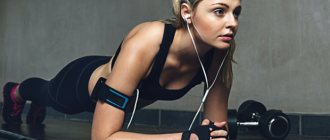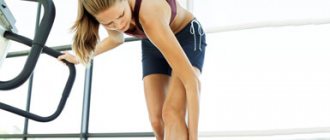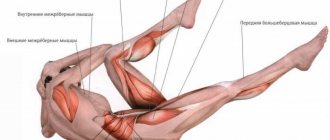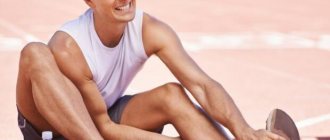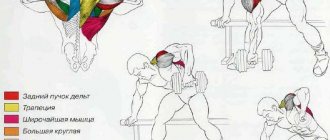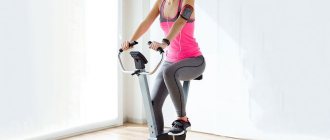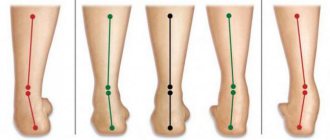1 October 2020 Admin Home page » Tips and tricks
Find out which muscles are activated when running. What works first and gets the maximum load.
The most common type of cardio exercise since childhood is running, which can be done at any time of the year and in any area, but not everyone knows what muscles work when running. In addition to strengthening the muscle groups of the lower body, the respiratory system develops well, bone tissue is strengthened, metabolism improves, muscle tissue and organs are better supplied with nutrients and oxygen.
You can learn more about the benefits of running here.
It is best when interval running is used (alternating slow and fast paces) and, of course, running over a distance where there is rough terrain, which allows you to diversify the load on the muscles - winding roads, ascents and descents help to influence muscle groups from different angles and with different load, which in total will bring a more tangible effect than monotonous laps at the stadium.
Running has a primary effect on the following muscle groups:
Buttocks
The largest muscle in the human body and, not unimportantly, the most attractive (the only rival in the female half is the pectoral muscles).
They include 3 gluteal muscle groups:
- small;
- average;
- big.
They begin to work to their full potential when the hip is retracted, that is, their work is associated with the hamstrings. The gluteal region is especially well worked out when running on a hill, when, upon contact with the surface, the load first falls on the quadriceps, and then the hamstrings and buttocks are included in the work.
Examples of running workouts to build muscle mass
Short-term, high-intensity running workouts such as HIIT can help you build muscle mass in your lower body, especially in your quadriceps and hamstrings (located at the back of your thighs) ().
Here are some examples of HITT workouts for building muscle:
- 6 sets of 20-second sprints at maximum intensity, separated by 2 minutes of walking or light jogging
- 5 sets of 30-second sprints at maximum intensity, separated by 4 minutes of walking or light jogging
- 4 sets of 45-second moderate-intensity sprints separated by 5 minutes of walking or easy jogging
- 4 sets of 30 second hill sprints separated by the time it takes to descend the hill
Try doing these workouts 3-4 times a week.
You can also change them depending on your comfort level and training experience.
For example, if you can't catch your breath between sets, increase your rest time or decrease the total number of sets. Conversely, you can intensify these workouts by decreasing rest time, increasing the number of sets, or both.
Either way, be sure to warm up before and cool down after to prevent injury and speed up recovery.
To prepare your body for exercise, jog or jump lightly for a few minutes, followed by dynamic movements such as lunges or squats ().
After training, walk at your normal pace for 5–10 minutes. Active recovery time helps lower your heart rate and prevents waste from building up in your muscles ().
Conclusion:
HIIT workouts can help you build muscle in your lower body. Warming up and cooling down can prevent injury and speed up recovery.
Caviar
Most people think that the calf muscle is one of a kind, but this is not so, it consists of two sections:
- calf - trained when raising on toes in a standing position;
- soleus - are located under the calf and are trained by raising your toes in a sitting position.
During running, active work begins when the heel leaves the ground, but the toe remains on the surface. Like the buttocks, the calf area is better trained when running on rough terrain.
What muscles work while running?
Jogging provokes very intense muscle work. But keep in mind that this is a cardio exercise, so it strengthens the muscles, but does not build them. The main muscles that are used when running are the buttocks and legs. Let's look at them in more detail:
- Thigh muscles. Located on the back of the thighs, they include four bundles and are responsible for the correct bending of the knees.
- Gluteal muscles. Helps keep the body in an upright position. They also shape the width and shape of the buttocks.
- Iliacus muscles. Responsible for the flexion functions of the lower leg. If pain and discomfort appear in these muscles while jogging, it is worth reconsidering the load.
- Quadriceps . They are located on the front of the thigh and take an active part in extending the leg and moving the knee and hip joints during running.
- Intercostal muscles. They tense up a little during forced inhalations and exhalations.
- Caviar . Located in the lower leg. They help raise your legs when jogging and are responsible for stabilizing the body.
In addition to the hip system, running also works the biceps, lower and upper abs. They work less actively, but are nevertheless involved.
Much also depends on your running technique. So, if we talk about which muscles swing when jogging, then the buttocks and the front surface of the thigh actively work. During sports running, the gluteal groups are actively worked out. The sprinting technique works the hip and calf muscles, but beginners should be careful with it, as damage to the knee joints can occur if the rules are not followed.
To strengthen your muscles and improve your posture, as you run, try to bring your shoulder blades closer to your spine and lower your shoulders. The arms, bent at the elbows, should move in a rhythm similar to the legs. Keep your abs slightly tense while running. But do not overdo it, so as not to lose your breath.
It is also worth considering which muscles are trained when running, depending on its technique.
Jogging on a flat surface
In this case, it is very important to follow the load regime and maintain the correct position of the body, head and upper limbs. By activating breathing, the load on the abdominal muscles and respiratory muscles increases.
The heart and muscles of the lower extremities receive a lot of load:
- gluteal;
- rear biceps of the thigh;
- anterior quadriceps femoris;
- tibial muscles;
- calf muscles.
If you want to strengthen your gluteal muscles, you can choose the so-called “sports” running, which involves transitioning your heel to toe when placing your foot. By choosing a sprint technique, you will put maximum stress on your calves and pelvic muscles.
Running uphill
What muscle groups are affected by uphill running? In this case, the anterior muscles of the lower leg and the muscles of the back are qualitatively Climbing uphill can be considered a power running technique, in which the leg pushes off as if from the hip. The descent must be performed through wide movements and through the involvement of various muscle structures.
Running up the stairs
This type of running maximally works out cardiac, pulmonary, and vascular functions , as a result of which metabolism accelerates. Thus, in the process of movement, unlike a simple workout, more calories are burned. Descending from stairs is also Despite the fact that few calories are expended in this case, the buttocks and thighs receive a high-quality load.
Cross-country skiing
Skiing does not particularly increase muscle volume, but it does an excellent job of strengthening secondary muscles. Due to the smoothness of movement and the absence of force loads, the risks of injury to ligaments and joints are minimal.
The muscles involved in classical skiing are mainly the gluteal region and the lower abs. As for “skating” skiing, it works the lateral parts of the thighs .
In this case, the most important push-offs and sweeping movements are important, which is what ski poles are for.
Tibialis anterior muscles
They are located on the front of the lower leg and are activated when the toes are raised up and when the leg is straightened until it touches the surface. You can feel the tibial muscles working very well if you walk quickly upward for 10-15 minutes. Untrained people the next day or the day after such walking will feel pain in the muscles on the front of the lower leg.
If you are just starting to run, you will definitely feel the load on these muscles in the first days.
Features of strengthening muscles when running
Some athletes who use running to gain muscle mass try to artificially strengthen muscles that take minimal part in the work, using various weights. Experts have a very negative attitude towards this, since the loads are distributed unevenly and unnaturally. Therefore, you shouldn’t go against the grain, so to speak. It's better to strengthen your running muscles naturally and use strength training exercises to build muscle mass in the desired areas. Please also consider the following recommendations :
- To strengthen the muscular structures of your back and posture, keep your shoulders down when running. Try to bring your shoulder blades as close to the spine as possible, and bend your arms at the elbow joints and keep them parallel to the ground surface. While jogging, your elbows should move with your legs in the same beat.
- To work your abdominal muscles while running, slightly tense them. Correct and complete breathing plays a role in this matter.
- To strengthen the hips, both the back and front muscles, it is recommended to choose jogging, in which the legs are positioned from toe to heel.
- And to pump up the gluteal muscles, follow the reverse technique, in which the foot is first placed on the heel and then on the toe.
- If you want to strengthen your hip and calf muscles, use a running technique that pushes your entire foot off the ground.
When running the latter technique, be sure to monitor your knee joints to prevent injury.
Also speaking about which muscle groups work when running, it is necessary to note the muscles of the back, neck and arms, especially the biceps, which are responsible for rotating the forearms and bending the arms at the elbows.
Please note that you should not expect great results from running in terms of gaining mass. It helps to increase muscle tone, as a result of which they harden and slightly increase in volume. Running also helps make the body stronger and more resilient. Over time, you will be able to run more without feeling discomfort. Don't be afraid to pump up your thighs or calves - this will require exercises of a different nature.
In any case, the muscles working when running are worked out efficiently. Before you start training, you should decide on your goals, which will allow you to choose the right technique and create a competent program. Also remember that the effectiveness of training is entirely determined by the regularity and duration of the training process.
Proper nutrition for building muscle mass through running
Good nutrition is just as important to building muscle as running itself. Without getting enough nutrients—especially protein—your body won't be able to support muscle building.
Protein
While exercise stimulates MPS, protein further enhances it by helping to increase muscle mass (,).
This is why many people drink a protein shake at the end of their workout.
To gain muscle mass, experts recommend consuming 1.4–2 grams of protein per kg of body weight daily. This equates to 96–137 grams of protein for a 68 kg person (, ).
Good sources of protein include meat, poultry, dairy products, fish, eggs, soybeans, beans and other legumes.
Carbohydrates and fats
Carbohydrates are your body's preferred source of energy, especially for anaerobic exercise such as sprinting.
Low-carbohydrate, high-fat diets, such as the ketogenic diet, have been shown to negatively impact anaerobic physical performance ().
Fat tends to serve as a source of energy during lower-intensity exercise such as long-distance running ().
To fuel your workouts and ensure your body gets enough vitamins and minerals, aim to get 45-65% of your calories from carbohydrates and 20-35% from fats ().
Healthy sources of carbohydrates include fruits, whole grains, starchy vegetables, dairy products and beans, while good sources of fat include fatty fish, extra virgin olive oil, whole eggs, seeds, avocados, nuts and nut butters.
Water
Water helps regulate body temperature and other body functions.
Your personal water needs depend on several factors, including age, body size, diet and physical activity level. However, the National Academy of Medicine generally recommends that men and women get 3.7 L and 2.7 L, respectively ().
These recommendations are for adults aged 19 years and older and include water from food and beverages.
Most people can stay hydrated by eating healthy foods and drinking water when thirsty and during and after exercise ().
You can find out how you can increase your water intake on this page – 12 Simple Ways to Drink More Water.
Conclusion:
A healthy diet is an essential part of building muscle while running. Make sure you drink enough water and consume adequate amounts of protein, carbohydrates and fat.
The abs are not pumped up during the first running workouts
Why is abdominal running not recommended for beginners? There are several reasons:
- This type of running is a power run. It uses the body's glycogen reserves, which are scant for a beginning runner.
- The structure of muscle tissue fibers in an untrained person does not allow repeated power movements.
- Some types of running that help strengthen the abs require intense work of the cardiovascular and respiratory systems. Therefore, the body must have a certain level of fitness.
As a rule, for beginners, the abdominal muscles cannot be felt even when trying to strain.
Advice
For the press to be obedient, it must be constantly strengthened, otherwise you simply will not be able to feel it and strain it. If this happens, then pump up your abs with exercises.
They can be practiced by both beginners and experienced runners. Otherwise, pain may appear in the area of the back and kneecaps when running.
What are the benefits of running for your abs?
When running, many different muscles are used. While your arms, legs, and hips are moving actively, your core muscles are in constant tension.
According to a 2009 study published in the medical journal Applied Physiology, Nutrition and Metabolism, running actively recruits your abdominal muscles. In addition, the muscles of the lower and middle back are under constant tension. The most experienced athletes who took part in the study demonstrated maximum engagement of the abdominal muscles. However, for all participants, the degree of activation of this area was lower than when performing abdominal exercises, such as crunches. As a result, it was concluded that running contributes to the formation and strengthening of the core muscles, but does not directly pump up the abs when running.
Do your legs lose weight or sway when you run?
This is a very important question for many runners. Let's say that if a representative of the fair sex has legs that are a problem area and she needs to lose weight rather than build up muscles in her thighs and calves, then she wonders whether regular long-distance jogging will bring the desired result.
The best illustration to answer this question is professional marathon runners. Please note: their legs are not very voluminous, and sometimes they are much thinner than those of most other people. Here is the answer to the question: do regular long-distance jogging make your legs lose weight?
The fact is that when we run, we actively use slow muscle fibers, which grow slowly from physical activity, unlike fast muscle fibers.
Therefore, if you have fat deposits in the legs, regular jogging is your option, in addition, the Adidas company has opened a sports base “Runbase Adidas” in Moscow, where you can not only have a great run with a trainer, but also just have a good time.
Adidas has opened a sports base “Runbase Adidas” in Moscow. When copying material, a link to the source is required:
However, you need to remember that running is not just a marathon, but also, for example, sprint races - short-distance running competitions. Compare marathon runners and sprinters: these are completely different types of athletes.
Sprinters' legs are much more massive, since during sprint races the fast muscle fibers mentioned above are used. With their help, you can make maximum effort in a short time, but in terms of endurance they are significantly inferior to slow ones. Many sprinters specifically pump up their legs with strength training in the gym.
Therefore, if your goal is not so much to lose weight as to pump up the muscles of your legs, thighs, and buttocks, squat with a heavy barbell. Regular jogging over long distances is unlikely to pump up your legs much.
